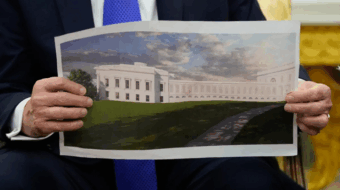Progressives are rightfully condemning the dirty debt deal.
It was a kind of double “hostage crisis,” that is, the Republican Right enforcing party discipline on the whole Republican Party and then having the Democratic leadership and the Obama administration negotiate with them largely on their own terms, to the detriment of all except the right.
Proclaiming that both parties are parties of monopoly capital and this proves it, while true in a sense, is also, along with blaming Obama (today I heard one angry liberal senior citizen call him an “economic Uncle Tom”), counterproductive and very much beside the point.
What is to be done and what can be done?
First we should look at a little history. The U.S. government had no debt ceiling until U.S. entry into World War I. when it instituted a partial ceiling on debt accrued from the sale of war bonds called Liberty Bonds.
The present aggregate debt ceiling was put into effect by a conservative coalition in Congress in 1939. It happened after the right wing had made major gains against the New Deal government, in the 1938 elections, using the sharp recession and whipping up a backlash against the mass strikes that had swept the country. The right used the slogan “Spend and spend, tax and tax” to win enough seats in Congress to block further New Deal legislation and attack the budgets of existing programs.
The purpose of the debt ceiling, as everyone with any sense knew at the time, was to cripple New Deal social programs and social spending.
The “ceiling” was established at $45 billion when the debt itself was $40 billion. It was raised to $300 billion during World War II. Then it dropped off to $275 billion and stayed that way through the Korean War, which the Truman administration funded with major progressive (tax-the-rich) tax increases with no harm to the economy – the economy continued to boom.
Since then of course it has been raised many times, especially from the beginning of the 1980s.
There are many nations that don’t have a “debt ceiling” and we don’t have to have one either. It isn’t in the Constitution. As noted above, we didn’t have any at all until the partial one in 1917, and we did not have the overall ceiling until 1939.
With the present deal the Republicans are moving to do what the conservative coalition tried to do in 1939.
As for the deal itself, it can be broken in a creative way by the Democrats, who can delay, undermine, and resist its implementation.
For example, what about social program “overruns”? The real cost of military spending is much higher than the official costs because the contractors in effect know that they will spend more than the original estimates, and do so with political acceptance. How about “quietly” not cutting Social Security, Medicare, etc. and then announcing “human capital” overruns. (I am really not kidding).
What about the right-wing Republicans? They don’t control the Senate and their control over the House can be stalemated by mass pressure on vulnerable Republicans, in particular from senior citizens, once the public begins to understand that the “done deal” can be undone.
Also, one can campaign to take the “debt ceiling” out of politics by eliminating it. Its initial purpose was to block social spending. It has been raised from $45 billion in 1939 to over $14 trillion today to pay for wars, fund the military-industrial complex and of course over the last 30 years pay for enormous tax cuts for the corporations and the wealthy.
The present deal can only reduce purchasing power and increase unemployment, so let’s undo it. So many Democrats have broken so many promises to their constituents and supporters on the center-left that they can certainly break this deal’s promise to their enemies.
But you say, what about default? All of this happened because of the Democrats fear of default – the bond ratings, Standard and Poor’s, inflation, high interest payments.
An economist friend of mine told me something very interesting the other day. Before this deal, he heard a discussion by the leaders of an association of credit raters,representing Standard and Poor’s and other major raters. They pretty much said that they didn’t really understand what was going on in Washington. The trends on bond interest were down. The U.S. was the largest economy in the world – it wasn’t Spain or Greece. Even a short-term default wouldn’t have much of an effect on anything, and the U.S., because of its central role in the global economy as both a producer and a consumer, had a lot of bargaining power and wiggle room to operate. The Chinese and Japanese for example, the major U.S. creditors, were not going to sell off U.S. bonds given their relationship to the U.S. economy.
These statements, coming from fairly reasonable representatives of finance capital, suggest that the administration and the Democrats really didn’t have to panic and cave in. It also suggests that they can begin now, with major support from people’s movements, to undo this done deal.










